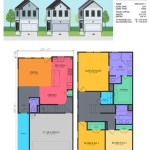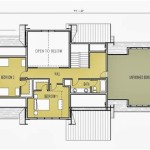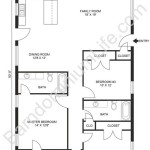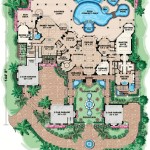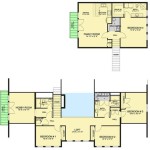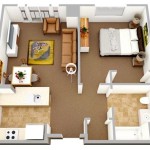Single Level House Plans With Basement: Expanding Your Living Space Downward
Single-level house plans, also known as ranch-style homes, are characterized by their horizontal layout, offering ease of access and a cohesive flow throughout the living spaces. While traditionally constructed on a slab or crawl space, incorporating a basement into a single-level design can significantly enhance the functionality and value of the property. This combination presents a compelling option for homeowners seeking the convenience of single-story living with the added benefit of extra space for storage, recreation, or even additional living quarters.
The integration of a basement into a single-level house plan requires careful consideration of several factors, including the site's topography, soil conditions, local building codes, and the intended use of the basement space. The added excavation and construction complexities can impact the overall cost and timeline of the project. However, the potential benefits, such as increased living area, improved resale value, and enhanced storm shelter capabilities, often outweigh the initial investment.
This article will explore the key considerations and advantages associated with single-level house plans featuring a basement, providing insights into design options, construction challenges, and the overall value proposition of this architectural approach. We will delve into the specific aspects that make this house plan a compelling choice for various needs and lifestyles.
Key Considerations Before Choosing a Single-Level House Plan with a Basement
Before committing to a single-level house plan with a basement, it is crucial to thoroughly assess several critical factors that can influence the feasibility, cost, and success of the project. These factors range from site-specific conditions to design considerations and regulatory requirements.
Site Assessment: The first and perhaps most crucial step is a comprehensive site assessment. This involves evaluating the soil composition, groundwater levels, and the slope of the land. Soil conditions can significantly impact the cost and complexity of basement construction. For instance, expansive soils may require specialized foundation designs to prevent cracking and heaving. High water tables necessitate robust waterproofing measures and potentially a sump pump system to prevent water intrusion. The slope of the land influences the type of basement that can be constructed. Walk-out basements, where one or more walls are exposed to the exterior, are ideal for sloping sites. On relatively flat sites, a standard basement with an emergency egress window may be the more practical option.
Local Building Codes and Regulations: Compliance with local building codes and regulations is mandatory. These codes dictate minimum ceiling heights, egress requirements (i.e., emergency exits), ventilation standards, and fire safety measures for basements. Egress windows or doors are typically required in basement bedrooms to ensure safe escape in the event of a fire. Zoning regulations may also impose restrictions on the size and placement of the house on the lot, impacting the overall design of the single-level structure and the dimensions of the basement. Failing to adhere to these regulations can lead to costly delays and rework during construction.
Budget and Cost Estimations: Constructing a basement adds a significant expense to the overall project cost. Accurate budgeting and cost estimations are essential to avoid financial surprises. The cost of basement construction varies depending on the size of the basement, the depth of excavation, the type of foundation, the complexity of the design, and the level of finishing. It's advisable to obtain multiple quotes from reputable contractors and to factor in contingency funds to cover unexpected expenses, such as unforeseen soil conditions or changes in material costs. Omitting or underestimating costs associated with waterproofing, insulation, and HVAC systems can lead to long-term problems and increased operating expenses.
Advantages of Incorporating a Basement into a Single-Level House Plan
The addition of a basement to a single-level house plan presents a multitude of advantages, enhancing the functionality, value, and overall livability of the home. These advantages extend beyond simply adding extra square footage; they include practical benefits related to storage, recreation, and even storm protection.
Increased Living Space: A basement effectively doubles or triples the available living space in a single-level home, depending on the footprint of the house. This additional space can be utilized for a variety of purposes, such as creating a family room, home theater, game room, home office, or guest suite. Finished basements provide a versatile area that can be adapted to the evolving needs of the homeowner. For instance, a growing family may initially use the basement as a playroom and later convert it into a teen hangout or a separate living area for elderly parents. The flexibility of the basement space allows homeowners to tailor the home to their specific lifestyle and preferences.
Enhanced Storage Capacity: Basements offer ample storage space, alleviating the need for clutter in the main living areas. Unfinished portions of the basement can be used to store seasonal decorations, sporting equipment, tools, and other items that are not frequently used. Well-organized storage solutions, such as shelving units, bins, and cabinets, can maximize the utility of the basement for storage purposes. In homes with limited closet space, the basement can serve as a dedicated storage area for clothing, linens, and other household items. By keeping the main living areas free of clutter, the basement contributes to a more organized and aesthetically pleasing home environment.
Storm Shelter and Safety: In regions prone to severe weather, a basement can serve as a safe haven during storms, tornadoes, and other natural disasters. The underground location provides added protection from high winds and flying debris. Properly reinforced concrete walls and a solid foundation offer a sturdy barrier against the elements. Some homeowners choose to designate a specific area of the basement as a dedicated storm shelter, equipped with essential supplies such as water, food, and a first-aid kit. The added safety and security provided by a basement can offer peace of mind to homeowners in areas with a high risk of severe weather events.
Design Considerations for Single-Level House Plans with Basements
Designing a single-level house plan with a basement requires careful consideration of various aspects, including the layout, access points, lighting, ventilation, and finishing materials. The design should seamlessly integrate the basement into the overall aesthetic and functionality of the home.
Layout and Access: The layout of the basement should complement the design of the main level. Consider the placement of staircases, windows, and doors to maximize natural light and ventilation. Interior staircases leading to the basement should be conveniently located and easily accessible from the main living areas. For walk-out basements, exterior doors can provide direct access to the backyard or patio, creating a seamless transition between indoor and outdoor living spaces. The layout should also take into account the intended use of the basement space, ensuring that rooms are appropriately sized and configured for their designated purpose.
Lighting and Ventilation: Adequate lighting and ventilation are crucial for creating a comfortable and habitable basement environment. Natural light can be maximized by incorporating large windows or light wells. If natural light is limited, consider using a combination of recessed lighting, task lighting, and accent lighting to brighten the space. Proper ventilation is essential for preventing moisture buildup and maintaining air quality. Install exhaust fans in bathrooms and kitchens to remove excess humidity. A dehumidifier may be necessary in damp climates to control moisture levels. Regular air circulation helps to prevent mold growth and maintain a healthy indoor environment.
Finishing Materials and Design Style: Select durable and moisture-resistant finishing materials for the basement. Concrete floors can be sealed and stained or covered with epoxy for a modern look. Engineered wood, tile, or vinyl flooring are good options for areas that may be exposed to moisture. Use moisture-resistant drywall or cement board for walls and ceilings. Consider the overall design style of the home when selecting finishing materials and décor for the basement. Integrating the basement’s design with the main level’s aesthetic creates a cohesive and harmonious living space. For example, if the main level features a modern design, consider using sleek and minimalist finishes in the basement to maintain a consistent style throughout the home.

Single Floor House Plans With Basement Elegant E Story 28 Images 1 St One

3500 Sf 4 Bedroom Single Story Home Plan 3 Bath Basement Garage Car Chicago Peoria Springfi Level House Plans

3 Bed Craftsman Ranch Plan With Unfinished Basement Architectural Designs 135021gra House Plans

Versatile Spacious House Plans With Basements Houseplans Blog Com

Ranch Style House Plans With Basement All About Floor And More

Ranch House Plans Traditional Floor

3 7 Bedroom Ranch House Plan 2 4 Baths With Finished Basement Option 187 1149

Don Gardner Walkout Basement House Plans Blog Eplans Com

Ranch Homeplans Walk Out Basement Unique House Plans Floor

Craftsman House Plan With Walk Out Basement 4968

